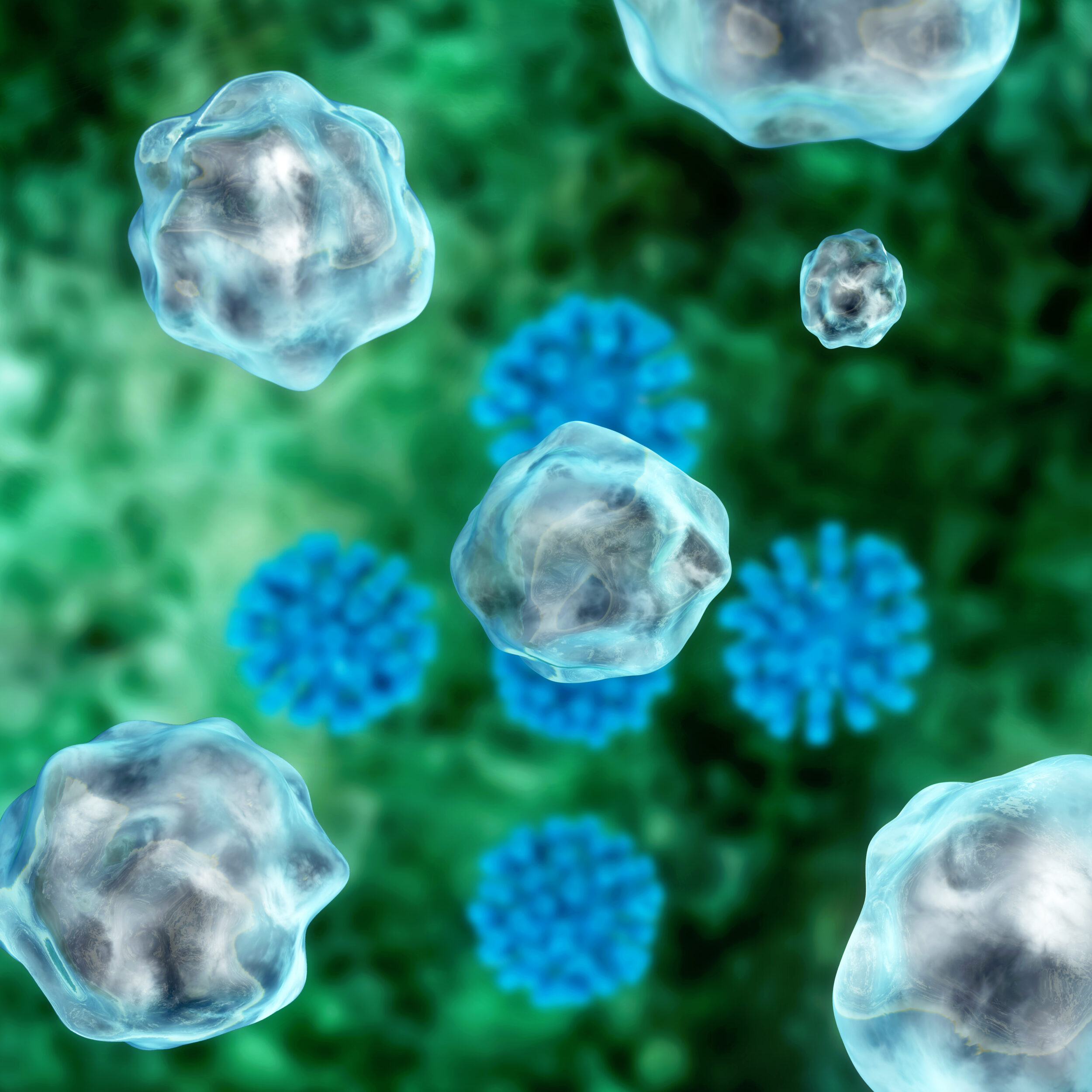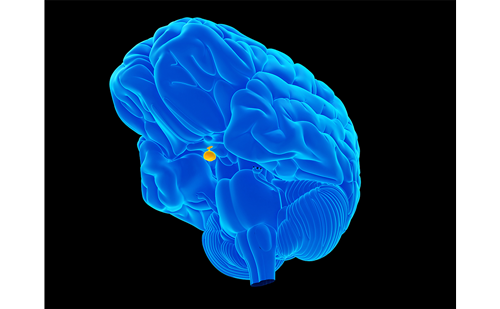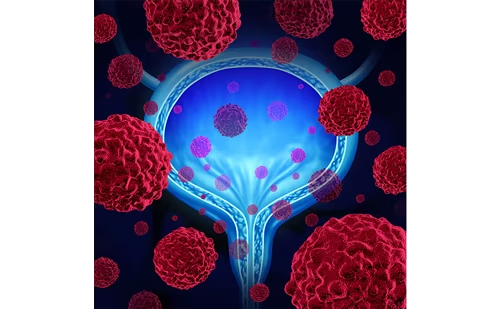Jongsma et al.1 demonstrated that proliferation of prostatic cancer cell lines under the condition of androgen depletion can be modulated by neuropeptides, which are known to be produced by neuroendocrine (NE) cells. This androgen suppression or depletion can lead to an induction of NE differentiation. If NE cells are androgen-independent, it is reasonable to suppose that androgen-receptor-negative NE cells would increase in number despite hormonal suppression and that tumours manifesting NE differentiation and androgen receptor negativity may be resistant to hormonal manipulation.
Jongsma et al.1 demonstrated that proliferation of prostatic cancer cell lines under the condition of androgen depletion can be modulated by neuropeptides, which are known to be produced by neuroendocrine (NE) cells. This androgen suppression or depletion can lead to an induction of NE differentiation. If NE cells are androgen-independent, it is reasonable to suppose that androgen-receptor-negative NE cells would increase in number despite hormonal suppression and that tumours manifesting NE differentiation and androgen receptor negativity may be resistant to hormonal manipulation. The NE component of prostate adenocarcinoma is resistant to hormone therapy; studies have shown that the number of NE tumour cells and chromogranin-A (CgA) serum levels increase when the human prostate tumour is omitted from hormonal therapy.1–3 NE differentiation detection may help to identify patients who are prone to endocrine therapy failure.
Ahlgren et al.4 studied the extent of NE differentiation in prostate cancer after three months of hormonal treatment. Radical prostatectomy specimens from patients randomised to three-month neoadjuvant luteinising hormone-releasing hormone (LH-RH)-analogue treatment or to surgery alone were available for the analysis. Both the number of CgA positive cells and the proportion of NE positive tumours were significantly greater (p<0.003) in the neoadjuvant group than in the control group. NE differentiation did not correlate to the decrease in serum prostate-specific antigen (PSA) after hormone therapy.
The authors have analysed the serum concentration and prostate gene expression (through reverse transcription-polymerase chain reaction (RT-PCR)) of CgA and PSA in patients affected by prostatic cancer and benign prostate hyperplasia (BPH).5 In patients with prostate cancer, tissue samples for the analysis were obtained from radical prostatectomy. These patients will be progressively stratified on the basis of the Gleason score and neoadjuvant LH-RH-analogue therapy (three or six months). The authors found that in prostate cancers treated with LH-RH-analogue serum, CgA levels were significantly higher (p<0.01) than in the untreated group. On the contrary, PSA serum levels were higher in the untreated group when compared with treated prostate cancer cases. CgA and PSA messenger RNA (mRNA) were expressed in all the prostate tissue samples analysed (both BPH and prostate cancer), with the highest levels being in prostate cancer tissue (p<0.01). When considering treated and untreated prostate cancer cases separately, CgA mRNA levels were significantly higher (p<0.05) in treated than in untreated cases of prostate cancer. In contrast, the levels of PSA mRNA were significantly higher in untreated than in treated cases.
The prostate cancer cases were stratified on the basis of the Gleason score. The highest serum and mRNA levels of CgA were observed in patients with a Gleason score of more than 7, and the difference between treated and untreated cases was more significant if limited to the analysis of a Gleason score of more than 7. These results suggest that hormone therapy in prostate cancer induces different effects on PSA and CgA. There are several hypotheses that must be considered:
- CgA may represent a useful marker to detect progression in poorly differentiated prostate cancer.
- CgA may help to analyse androgen-independent growth and progression in prostate cancer.
- If CgA mRNA expression reflects NE activity in the prostate, continuous androgen suppression therapy seems to produce a hyperactivation of NE cells in the prostate. This may be one of the mechanisms used for prostate cancer to progress during hormone therapy in an androgen-independent tumour.
All of these aspects would have significant implications for the treatment of hormone-therapy-resistant prostate cancer.
Influence of Continuous and Intermittent Androgen Deprivation Therapy on NE Differentiation
The authors prospectively analysed changes in serum CgA levels in patients with prostate adenocarcinoma who successfully responded to the first 24 months of intermittent androgen deprivation (IAD) therapy, compared with continuous hormone therapy. In both groups, complete androgen deprivation (CAD) using LH-RH agonists (triptorelin 3.75mg) in combination with an anti-androgen (flutamide 250mg) every eight hours was performed. Two different populations were analysed:
- type 1: pT3pN0M0 prostate adenocarcinomas with biochemical (PSA) progression after radical retropubic prostatectomy (RRP); and
- type 2: metastatic prostate carcinomas (tumour node metastasis (TNM) classification 1997)6 directly submitted to CAD.
In each population, cases were randomly assigned to IAD or continuous therapy.
The hypothesis analysed by the authors in this study concerns whether the intermittent administration of androgen deprivation therapy may reduce the risk of an increase in CgA levels and a hyperactivation of NE prostate cells. In this study, the authors confirmed the effect of continuous CAD therapy on serum CgA levels and analysed the differences using IAD therapy. IAD is proposed in prostate cancer patients to delay the time to tumour progression due to castration therapy resistance.7 Using IAD therapy, it is possible that the cyclic replacement of androgens during the ‘off’ therapy phases reduces the possibility of NE hyperactivation and serum CgA increase produced by CAD therapy. Using the analysis of variance, the difference between IAD and continuous CAD therapy on the overall CgA measurements only reached statistical significance in population type 1 (locally advanced tumours; p=0.001) but not in population type 2 (metastatic tumours; p=0.080). Clear evidence for a main therapy effect on CgA levels was therefore only obtained in population type 1. However, in both population types 1 and 2, a significant trend for CgA levels to increase during continuous CAD but not during IAD (linear regression model) was found.8
Effect of Non-steroidal Anti-androgen Monotherapy Versus Castration Therapy on NE Differentiation in Prostate Carcinoma
Patients with pT3pN0M0 prostate cancer and biochemical progression (defined as a PSA>0.4ng/ml) within 12 months of RRP were enrolled. Patients were randomised to bicalutamide 150mg daily or triptorelin 3.75mg monthly. Serum CgA levels were analysed at baseline (PSA progression) and one, three, six, 12, 18 and 24 months after randomisation.
Only patients who concluded and successfully responded to the first 24 months of treatment were analysed. All had PSA progression within 12 months of RRP. In particular, a statistically significant trend was noted for CgA levels to increase from baseline to 24 months (slope=0.60; 95% confidence interval (CI) 0.28–0.92; p=0.004) in the castration group. A statistically significant but lower trend was found in the bicalutamide group (slope=0.29; 95% CI 0.08–0.50; p=0.01).
At the 12-month follow-up, the serum CgA levels were significantly lower in the bicalutamide group than in the castration group (p=0.0433), which was greater at the 24-month follow-up (p=0.0025). The median increase in serum CgA levels from baseline to 12 and 24 months was lower in the bicalutamide group (25.4%, range 1–42.8%; and 30%, range 1–48.6%, respectively) than in the castration group (48.9%, range 27.2–82.4%; and 60.2%, range 16.6–78.2%, respectively).
When stratified by the Gleason score (<7 and ≥7) at baseline, the serum CgA levels were greater in patients with a Gleason score of 7 or more (bicalutamide 38.04ng/ml ± 6.34ng/ml; triptorelin 35.22ng/ml ± 6.52ng/ml) than in those with a Gleason score of less than 7 (bicalutamide 24ng/ml ± 2.41ng/ml; triptorelin 23.77ng/ml ± 2.26ng/ml) in both groups (p<0.0001). At the 12-month follow-up, statistically significant differences were found between the bicalutamide and triptorelin groups in serum CgA levels in patients with a Gleason score of 7 or greater (46.0ng/ml ± 5.4ng/ml compared with 50.83ng/ml ± 4.92ng/ml; p=0.0094) but not in patients with a Gleason score of less than 7 (27.65ng/ml ± 0.95ng/ml compared with 27.2ng/ml ± 4.77ng/ml; p=0.6857). This was also true after 24 months of follow-up (Gleason score ≥ 7, 47.37ng/ml ± 5.18ng/ml compared with 54.58ng/ml ± 6.14ng/ml, p=0.0001; Gleason score ≤ 7, 27ng/ml ± 1.79ng/ml compared with 29.45ng/ml ± 1.1ng/ml, p=0.1478). The greatest increase in serum CgA levels was found in the castration group with a Gleason score of 7 or greater (baseline to 24 months, median increase 54.8%, range 33.3–78.2%).
To the authors’ knowledge, this is the first report to indicate that non-steroidal anti-androgen monotherapy has less effect on serum CgA levels in prostate cancer than castration.9
NE Differentiation in Hormone Refractory Prostrate Cancer – Treatment Choice
Oestrogens and Somatostatin Analogues – Rationale
The mechanism of action of oestrogens in prostate cancer consists of different targets. Oestrogens effect negative feedback inhibition of the LH-RH axis, producing biochemical castration within three to nine weeks. As shown in hormone-insensitive prostate cancer cell lines, they can also exert a direct cytotoxic effect at the prostate cell level, leading to mitotic arrest and apoptosis. Some authors have suggested that oestrogens may influence prostate carcinogenesis via paracrine mechanisms mediated by the stromal microenvironment.10,11
Diethylstilbestrol (DES) is the prototypical oestrogen for prostate adenocarcinoma treatment. The European Organisation for the Research and Treatment of Cancer (EORTC) trial 30805 demonstrated the equivalent efficacy of 1mg DES daily to orchiectomy.12 Another trial also showed superior results over anti-androgen monotherapy.13 Interest in oestrogen therapy has also been rekindled by recent trials, suggesting that the parenteral administration of oestrogens may avoid a majority of cardiovascular (CV) toxicity. Most recently, Ockrim et al.14 reported encouraging biochemical results in 20 patients with locally advanced or metastatic cancer treated with transdermal oestradiol patches. In conclusion, the last International Consultation on Prostate Cancer recommended that oestrogens should remain a mainstay of secondary therapy.10 Efforts should be made to secure more reliable availability of the preparation and avoid the CV toxicity of DES.
Native somatostatin is characterised as an inhibitory peptide with exocrine, endocrine and autocrine activity.15 The general inhibitory function of somatostatin is wide-ranging and affects a number of organ systems. The effect of somatostatin on organ systems is thought to be mediated via specific somatostatin receptors (SSTRs). Five subtypes (SSTR1–5) have been identified and cloned in human tissue.
High-SSTR2-affinity octapeptide somatostatin analogues, such as octreotide, remain the drugs of choice for application in a majority of pure NE tumours as such tumours most often predominantly express SSTR2.16 However, other somatostatin derivatives, such as lanreotide, which have good affinity for SSTR5 in addition to the affinity for SSTR2, may advantageously identify SSTR5-expressing tumours. The primary effect of somatostatin analogues is not a direct cytotoxic effect of NE cells, but an inhibition on the release of various peptide hormones secreted by NE cells.17 The observation that somatostatin analogues inhibit the release of various NE products has stimulated interest in their use as antiproliferative and pro-apoptotic agents. Antiproliferative and pro-apoptotic actions of somatostatin analogues have been demonstrated in various tumour models, including those of the breast, prostate, colon and pancreas.
Somatostatin Analogues in Combination Therapy – Rationale and First Experience
The mechanism of action of somatostatin analogues may suggest the use of these drugs not as monotherapy, but as combination therapy for tumours (such as prostate cancer). However, the in vivo response of malignant cells to anticancer therapies is directly influenced by the local microenvironment in which they reside (or metastasise).18 Microenvironment factors may attenuate the anti-tumour activity of several cytotoxic agents on neoplastic cells. In particular, organ sites frequently involved in advanced metastatic disease appear to confer on neoplastic cell protection from anticancer drug-induced apoptosis.
The development of survival factor-mediated resistance to anticancer therapies is a major hurdle preventing long-lasting clinical responses to conventional or investigational therapies.18 This realisation led to the novel concept of anti-survival factor (ASF) therapy for prostate cancer as a component of anticancer treatments and to the concept of combination therapy for hormone refractory disease. On this basis, Koutsilieris et al.18 first proposed combination therapy with dexamethasone and long-acting somatostatin analogue in patients with stage D3 prostate cancer. Among its diverse pharmacological effects, dexamethasone acts to downregulate the growth hormone (GH)-independent local bioavailability of insulin-like growth factor-I (IGF-I), whereas somatostatin analogue suppresses the level of GH-dependent IGF-I.
In patients with metastatic androgen ablation refractory prostate cancer, the authors proposed a different approach – they discontinued the LH-RH analogue and started combination therapy with ethinyloestradiol and lanreotide acetate. The rationale for the authors’ combination therapy was:
- to inhibit the protective (anti-apoptotic) effect of the NE system on prostate adenocarcinoma cells (somatostatin analogue);
- to use a new mechanism to induce castration (oestrogen); and
- to add a direct cytotoxic effect on prostate cells (oestrogen) (see Figure 1).
It has also been shown that the B-cell chronic lymphocytic leukaemia (CLL)/lymphoma 2 (Bcl2) proto-oncogene (an anti-apoptotic factor) is preferentially expressed in foci of prostate adenocarcinoma cells in the vicinity of NE differentiation.19,20 In hormone refractory (D3) prostate cancer, NE cells may protect prostate adenocarcinoma cells from anticancer therapies through the neutralisation of pro-apoptotic intracellular pathways.
The rationale for somatostatin analogue therapy for D3 prostate tumours is not only to directly induce cancer cell apoptosis, but also to neutralise the protective effect conferred on cancer cells by survival factors derived by NE prostate cells and the microenvironment. The somatostatin analogues octreotide and lanreotide are of high SSTR2 affinity.16,21 Considering the predominant localisation of SSTR2 in the stromal compartment of the prostate and peri-tumour blood vessels (and not on NE prostate cells), the effects of these analogues might be indirect by stromal control.22 However, somatostatin analogues seem to interact at tissue level, also through a receptor-binding-independent mechanism.17
The authors prospectively evaluated 10 consecutive patients with stage D3 disease who received combination therapy consisting of oral ethinyloestradiol (1mg daily) and lanreotide (73.9mg lanreotide acetate intramuscularly every four weeks). In this first experience, 90% of cases (95% CI 55.5–99.8%) had an objective complete (PSA<4ng/ml) or partial (≥50% PSA decrease from baseline) clinical response to combination therapy, corresponding to a statistically significant (compared with baseline refractoriness) rate of re-introduction of responsiveness to the combination with lanreotide and ethinyloestradiol (McNemar’s paired chi-square test; p<0.01). In all cases, PSA responses were accompanied by a concomitant, statistically significant decrease in the bone pain score (p<0.0001) as well as by significant improvement in the Eastern Cooperative Oncology Group (ECOG) performance status score (p<0.0001). The symptomatic improvement in pain and performance status appeared to be temporally associated with changes in objective response markers, and it is suggested that the main mechanism of action of this combination therapy affects mechanisms regulating the growth and/or survival of metastatic cells rather than involving a non-specific antiinflammatory or analgesic effect.24 The median duration of the bone pain response, ECOG response and progression-free survival was 17.5 (95% CI 12–19), 18 (95% CI 12–19) and 18.5 (95% CI 14–21) months, respectively, in the authors’ study and 13 (95% CI 12–14), 19 (95% CI 13–25) and seven (95% CI three to 10) months in the study by Koutsilieris et al.24
A comparison of serum CgA at baseline during follow-up, at maximal response and at relapse from therapy, revealed a significant change in CgA during the course of combination therapy (Friedman’s non-parametric two-way analysis of variance (ANOVA); p<0.0001). The authors observed a significant decrease in serum CgA during the administration of combination therapy (median maximum decrease 38.4%, 95% CI 33.2–50.3, range 28.6%–64.9%) compared with baseline CgA. The significant decrease in circulating CgA documented in this cohort of patients suggests that a reduction in NE activity on prostate cancer cells may be a mechanism accounting for at least part of the encouraging responses that were observed.
A limit of the authors’ analysis may be the sole determination of serum CgA expression; however, none of their patients presented with a history of other disorders known to interfere with CgA levels. Some groups have reported a significant correlation between serum and tissue expression of CgA in prostate cancer.19,25
Results continue to be encouraging and supportive of the rationale for the authors’ combination therapy. In January 2004, 19 of the 20 cases (95%) showed an objective (complete in five cases, or 25%, and partial in 14 cases, or 70%) clinical response to combination therapy, as demonstrated by at least a 50% PSA decrease from baseline. The biochemical response was accompanied by a decrease in the number of bone metastases on bone scan in only one case. Two of the 20 patients (10%) died of prostate cancer at 10 and 16 months, respectively, and six patients (30%) had clinical progression with PSA increasing to more than 50% of the PSA nadir at a mean of 7.8 months (median seven, range four to 12) during follow-up. The other 14 patients (70%) were still without disease progression at a median of 16.5 months (mean 13.9, range four to 24) of follow-up.
Conclusion
The combination of ethinyloestradiol and lanreotide had a favourable toxicity profile, and offered objective and symptomatic responses in patients with limited treatment options and refractoriness to conventional hormonal therapy strategies. In particular, it offered a median overall survival that was superior to the 10-month median survival in patients with hormone refractory disease. This combination therapy also sustains the novel concept in cancer treatment in which therapies may not only target cancer cells, but also their microenvironment, which can confer protection from apoptosis. ■







